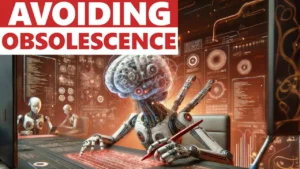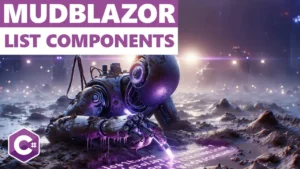In today’s digital age, coding has become an essential skill, not just for tech enthusiasts but for individuals across various professions. If you’re reading this, chances are you’re curious about diving into the world of programming but might be feeling a bit overwhelmed or unsure of where to start. You’re not alone. Many people want to learn how to start coding but are held back by preconceived notions or doubts about their abilities.
Whether you’re an artist, a teacher, a homemaker, or someone looking for a career change, coding can offer you a new way to express yourself, solve problems, and even open doors to new career opportunities. The beauty of coding is that it’s a universal language, applicable in countless fields, from designing websites to analyzing data or even creating digital art.
I’m hopeful that as you read through this, you can see how to start coding without having a seemingly insurmountable barrier in front of you.
Demystifying Coding Myths
“You Need to Be a Math Genius”
One of the most common misconceptions about coding is that it’s all about complex calculations and algorithms, reserved only for math whizzes. While certain areas of programming, like data science or game development, might require a strong mathematical foundation, many coding tasks are more about logic and problem-solving than advanced math. In fact, some of the most successful developers out there claim they’re not great at math at all. So, if math isn’t your strong suit, don’t let it deter you. There’s a coding niche for everyone.
“Coding is Only for Young People”
Age is just a number, especially when it comes to learning new skills. The tech world is filled with stories of individuals who began their coding journey later in life and found success. Whether you’re in your 30s, 40s, 50s, or beyond, it’s never too late to start coding. The key is passion, persistence, and the willingness to learn. Remember, coding is a skill, and like any skill, it can be acquired and honed at any age.
“You Need a Computer Science Degree”
While formal education can provide a structured learning path, it’s not the only way to become a proficient coder. The tech industry is replete with stories of self-taught developers who have built successful careers without a computer science degree. With a plethora of online resources, courses, and communities available, motivated individuals can learn to code from the comfort of their homes. Moreover, many tech companies now prioritize skills and portfolios over degrees, making it entirely possible to land a tech job based on your abilities and projects, rather than formal credentials.
Understanding the Core Concepts
What Does ‘Writing Code’ Mean?
At its essence, writing code is akin to teaching. Just as you might instruct someone on how to perform a task, coding is about giving instructions to a computer. Computers, unlike humans, require very specific and structured instructions. When you write code, you’re essentially creating a set of commands for the computer to follow. Think of it as writing down a detailed to-do list that the computer then executes, step by step.
The Idea Behind Algorithms
The term ‘algorithm’ might sound intimidating, but it’s a fundamental concept in coding. In simple terms, an algorithm is a set of instructions designed to perform a particular task. It’s like a recipe in cooking. Just as a recipe provides step-by-step instructions on how to prepare a dish, an algorithm offers a sequence of steps to solve a specific problem. For instance, a recipe might guide you in making a cake, while an algorithm could direct a computer to sort a list of numbers in ascending order.
Picking the Right Tools For Starting Coding
Choosing a Device
Starting your coding journey doesn’t necessarily mean you need the latest and most expensive device. For beginners, any functional laptop or desktop will suffice. If you’re on a tight budget, consider refurbished devices or even Raspberry Pi, a cost-effective mini-computer that’s perfect for learning programming.
Personally, I write all of my code on my laptop. I have secondary monitors to help maximize the information I see, so I very much appreciate the extra screen real estate. However, this isn’t feasible for all programmers, and I do recognize that I am fortunate to be in this situation. The key is to have a device that can comfortably run a web browser and a code editor, which are the primary tools you’ll need as you start.
Setting Up Your Coding Environment
When navigating how to start coding, you’ll need a space to write and test your code. For those who prefer an online, hassle-free setup, platforms like Replit or Glitch offer browser-based coding environments. These platforms are user-friendly and don’t require any installations.
However, if you’re looking to set up a local coding environment on your device, Visual Studio Code (VS Code) is a great place to start. It’s a free, lightweight code editor that supports multiple programming languages. Installing VS Code is straightforward:
- Visit the official Visual Studio Code website.
- Download the version suitable for your operating system (Windows, macOS, or Linux).
- Follow the installation prompts.
- Once installed, open VS Code, and you’re ready to start coding!
Remember, the tools you choose are just a means to an end. The real journey when figuring out how to start coding lies in learning, experimenting, and creating with code.
Dipping Your Toes: First Coding Exercises
Hello, World!
Every coder remembers their first “Hello, World!” program. It’s a rite of passage in the coding community. This simple exercise is designed to introduce you to the structure of a programming language and ensure your environment is set up correctly.
Now there are many languages you can start with as a beginner, and I can’t tell you which one is right for you. But if you were interested in starting with C#, for example, here’s how you can write a “Hello, World!” program it:
- Open your chosen code editor (e.g., Visual Studio Code).
- Create a new file and save it with a
.csextension, likeHelloWorld.cs. - Type the following code:
Console.WriteLine("Hello, World!");
Run the program. If everything is set up correctly, you should see the message “Hello, World!” displayed.
Simple Projects For Navigating How To Start Coding
Once you’re comfortable with the basics, you can start building simple interactive projects:
- Basic Calculator: Create a program that takes two numbers as input, performs arithmetic operations (like addition, subtraction, multiplication, division), and displays the result.
- Personal Diary Application: Design an application where users can write, save, view, and delete diary entries. This will introduce you to file handling and basic CRUD (Create, Read, Update, Delete) operations.
I fully believe that building projects is the best way to learn how to start coding and how to become a better programmer. You can start small (and I recommend you do) and start actually practicing what you’re learning!
Exploring Different Avenues of Coding
I should mention right at the start of this section: when considering how to start coding it can be overwhelming. I’ll only list a few different areas of coding, but the reality is that software development can aid in every single industry that you can imagine. So this is by no means a conclusive list, it’s just to get you thinking!
Web Development
Web development is all about building and maintaining websites. It’s split into two main areas:
- Front-end (or Client-side) Development: This involves creating the parts of the website that users see and interact with directly. Technologies commonly used include HTML, CSS, and JavaScript.
- Back-end (or Server-side) Development: This focuses on the underlying infrastructure, databases, and application logic. Languages like C# (with ASP.NET), Python, and Java are often used here.
Game Development
If you’ve ever dreamt of creating your own games, coding is your gateway. With platforms like Unity (which uses C#), even beginners can start crafting simple games. As you advance, you can delve into more complex game mechanics, graphics, and physics simulations.
Check out this video on some game project ideas and how to get started coding:
Data Analysis
In our data-driven world, the ability to analyze and interpret data is invaluable. Coding plays a pivotal role here. With languages like Python and its libraries (e.g., Pandas and Matplotlib), you can process, analyze, and visualize data. Whether it’s understanding user behavior on a website or predicting stock market trends, data analysis offers a wide range of possibilities.
Building a Daily Learning Habit
Setting Aside Dedicated Time
Learning to code, like any skill, requires consistent effort and practice. It’s not about how many hours you put in a single day, but the regularity with which you engage with the material. Here’s why consistency is key:
- Retention: Regular exposure to coding problems and solutions helps reinforce your memory. The concepts become familiar, and the logic starts to feel intuitive over time.
- Overcoming Plateaus: Every learner hits a plateau, a phase where it feels like you’re not making progress. Consistency helps you push through these phases and continue advancing.
- Building Muscle Memory: Just as a pianist practices scales to play without thinking, writing code daily helps you internalize syntax and structures, making the act of coding more fluid.
To ensure consistency:
- Set Clear Goals: Whether it’s mastering a particular concept or building a small project, having a clear goal gives direction to your learning.
- Dedicate a Specific Time: Allocate a specific time of day for coding. It could be early mornings, during lunch breaks, or late evenings. Find what works for you and stick to it.
- Minimize Distractions: Ensure your learning environment is free from unnecessary distractions. Turn off social media notifications, and create a quiet space dedicated to coding.
Tracking Progress
As you embark on your coding journey, it’s essential to track your progress:
- GitHub: This platform is not just for professionals. As a beginner, you can use GitHub to store, version, and showcase your projects. It’s a great way to see how far you’ve come and to share your work with others.
- Learning Diary: Maintain a diary or journal where you jot down what you learned each day, challenges you faced, and solutions you found. This not only helps in reinforcing concepts but also serves as a motivational tool when you look back at your journey.
Seeking Guidance and Feedback
Mentorship
While self-learning is a powerful tool, having a mentor can accelerate your growth. This is very helpful to consider when exploring how to get started coding:
- Experience: Mentors, with their years of experience, can provide insights that you might not find in books or online courses.
- Networking: A mentor can introduce you to a broader network of professionals, opening doors to job opportunities and collaborations.
- Direction: When you’re stuck or demotivated, a mentor can provide guidance, helping you navigate challenges.
To find a mentor, consider joining coding forums, attending local tech meetups, or leveraging platforms like LinkedIn to connect with experienced professionals.
Peer Review
Feedback is a crucial component of growth:
- Code Quality: Sharing your code with peers allows you to get feedback on its quality, efficiency, and readability.
- Learning from Mistakes: Constructive criticism helps you identify areas of improvement, ensuring you don’t repeat the same mistakes.
- Collaborative Learning: Engaging in code reviews exposes you to different coding styles and solutions, broadening your understanding.
Consider joining coding groups, online forums, or platforms like Stack Overflow to engage with a community, share your work, and learn from collective knowledge.
Preparing for the Long Haul
Overcoming Initial Hurdles
As you explore how to get started coding, you’ll encounter challenges unique to this endeavor. Here’s your guide on navigating through them:
- Break Problems Down: In your quest on how to get started coding, facing a complex problem is common. Slice it into smaller tasks to make it less daunting.
- Seek Help: As you discover how to get started coding, don’t hesitate to seek guidance on platforms like Stack Overflow or Reddit.
- Take Breaks: If a coding problem has you stumped, step away, and return with a fresh perspective.
- Stay Curious: Remember, every adept coder began with figuring out how to get started coding. Maintain a curious mind to continue learning and growing.
Celebrating Milestones
As you advance on your coding journey, celebrating your progress is crucial:
- Document Your Progress: As you learn how to get started coding, maintaining a portfolio of your projects showcases your growth.
- Share Your Achievements: Whether you’ve built a new app or mastered a complex concept in your journey of how to get started coding, share your wins with others.
- Reward Yourself: Set up rewards for milestones to keep yourself motivated as you continue to learn how to get started coding, propelling you towards your next achievement.
Wrapping Up How To Start Coding
Starting from zero and delving into the world of coding is no small feat. It’s a journey filled with challenges, but also immense rewards. As you continue to explore, experiment, and evolve, remember that every line of code you write is a step forward.
Embrace the continuous learning process, stay curious, and most importantly, enjoy the journey! The world of coding offers endless possibilities, and you’re just getting started. It will take time to build mastery in this space, just like anything else.
I hope that after reading this article you feel more comfortable about how to start coding! If you’re looking to boost your learning, subscribe to my weekly newsletter for software engineering topics directly to your inbox!




